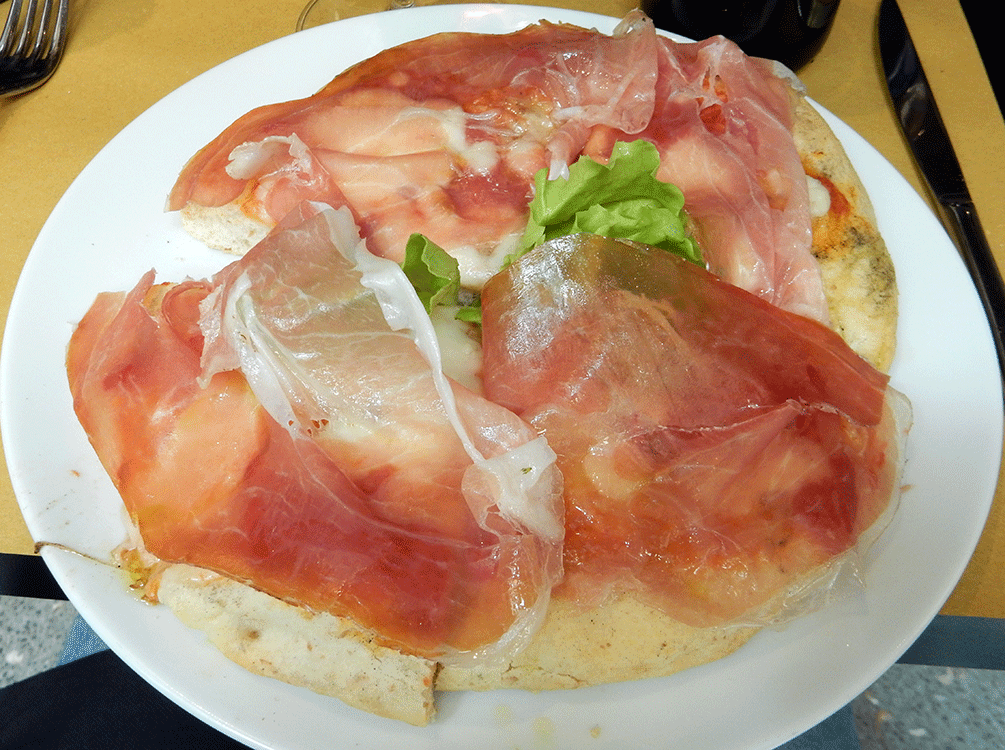Chef Roberto Pongolini is among the growing number of chefs who walk away from the pressure-cooker kitchens of a Michelin-starred restaurant. The chef closed his La Cantinetta in favor of an intimate contemporary bistro, Borgo 20. The informal setting is extremely comfortable and affordable.
The riso al parmigiana di collina at Borgo 20 is without a doubt one of the most memorable dishes ever to enter my mouth. Similar to a risotto but made with parmesan aged 29 months (yes, it does only get more incredibly flavorful with age) spiked with smoky bits of crispy pancetta counterbalanced by the sweetness of a prune or two on top. A dish that certainly bore repeating on another visit.
And the chef also bravely has tinkered with the traditional pizza, although the menu refers to its altered state by another name, pandiro, as a warning to purists. Using multiple grains and flours, the dough for pandiro lowers the speed limit of slow cooking. It is left to rise for five days with a wonderful result – a crust that somehow is rendered both thick and airy light, yet crispy on the outside. And, again, we had to have this more than once. We sampled one blanketed with Parma prosciutto and one with salad-like seasonal vegetables.
But wait, we also had our favorite dessert so far at Borgo 20. We have failed to become huge fans of Emilia Romagna’s Lambrusco, but Borgo 20 turns it into a refreshing, not-too-sweet sorbet topped with extremely drunken cherries. And, yes, it was just as good melting on our tongues on a subsequent visit.
Another neighborhood spot offering casual comfort at lunch time was Kimera. The squid ink pasta was studded with the contrasting paleness of tender calamari; fresh ricotta was smoothed into a rich tomato sauce in another pasta dish; and fresh asparagus brightened a creamy riso. A basil panna cotta was a perfect springtime dessert.
Normally, I wouldn’t include a first-stop restaurant selected only because it was nearby and we were starving, but Tiffany Wine Bar offers a surprisingly nice selection of salads. Thinly sliced bresaola, cured beef, served with fresh fruit and radicchio presents an ideal counter to so many regional heavy dishes. Tiffany also sits at a great corner for watching locals walk and pedal by on the narrow streets.
Trattoria Corrieri is one of the Parma classics that everyone says you must try. The massive gathering spot for huge tables of locals on weekends made for great people-watching, but we blew our ordering. We needed to order what they all did, but we placed ours before having time to spy on neighboring tables. This is the place to order heaping platters of thinly sliced meats and the traditional accompanying fried bread. Locals follow that course with a bowl of shared pasta. Mal-ordering aside, the convivial crowd made it worthwhile.
Our only stumble was our most expensive meal. In the kitchen’s defense, the owner (?) seemed to be having a bad day created by the police outside threatening to tow his car. The pretty salad was a great starter, but… amazingly for Italy, our pasta at the touted Gatta Matta was way overcooked. The pair of scallops in pureed cannellini was perfectly cooked, but even the pasta was overwhelmed by the quantity of the sparingly seasoned puree.
The photos above include shots of the huge wheels of parmesan cheese found at shops everywhere. Specialized stores offer primarily a combination of fine meats and regional cheeses.
And one thing we have yet to consume, at least not to our knowledge, is as prevalent as pork – horse meat. Parma does not shy away from its consumption. Not only is horse meat commonly found in butcher shops, but carne di cavallo in some format is on the menu of almost every restaurant in Parma, from the lowliest to toniest. The regional favorite is served tartar. Maybe next time?
For now, I’m dreaming of that Borgo 20 riso.
























